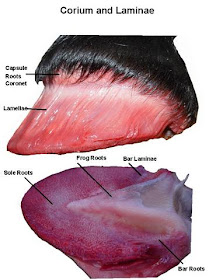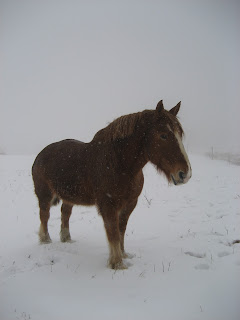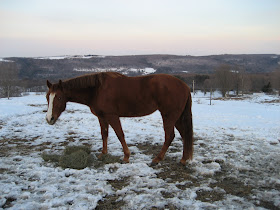What do the bars do?
Remember that the coffin bone is shaped like a half moon and that it sits in the front of the foot. Therefore the coffin bone is responsible for the shape of the front of the foot. Since the back of the foot is composed of soft tissue, what is in the back of the foot to help the hoof hold it's shape? The bars. They give the back of the foot the arch structure that the coffin bone gives to the front of the hoof.What are the bars made of?
It might be easier to think of the bars being half-wall and half-sole. They need to be stiff enough to hold the structure, but not so stiff that they don't have any give at all. Remember, the bars and the walls aren't quite the same thing, but even more importantly the bars and the sole aren't the same thing at all. How do you manage the bars?
There is some confusion about this, even the barefoot schools don't agree on this. For example, Pete Ramey recommends leaving the bars alone.Quick aside about Pete Ramey's trim: I think Pete Ramey is great. He has done fantastic things for the barefoot movement. If you want to learn about hooves start with Pete Ramey. But know that he teaches a very conservative trim. His trim is a great place to start and a good way to maintain healthy hooves, but if your horses have some issues you'll need to branch out after you've learned the basics from him.
But you need to trim the bars! Bars are tricksy little things that if given free rein will go crazy and grow over the rest of the hoof. Literally. Bar is much stiffer and stronger than sole, if it grows over the sole it will actually reduce hoof function by not allowing the hoof to flex as it should; if it grows too far it will actually cause the corium to stop growing sole!
So how do you spot it?
You develop an eye.Take this foot for instance:
It's pretty easy to tell looking at this hoof that the bars have overgrown, right? There's an obvious ridge running all the way from the heels around the apex of the frog. But given the state of the walls you're not too surprised to see it.
How about this hoof?
 |
| Photo from a barefoot trimmer |
 |
| Photo from a farrier |
Fortunately I happen to have a horse that doesn't have bar material growing over the sole.
 |
| Coriander's right fore, with some hay and poo for funsies |
 |
| Gwen's left hind |
































